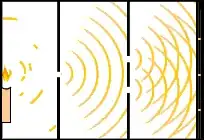Yes, the waves are and should be (approximately) sine waves. A proper animation would show the intensity at each point, so it would need a continuum of colors. For the sake of simplicity, the Wikipedia animation only shows the places where the sine wave approaches the maximum in orange.
Each slit is the source of the waves according to the Huygens-Fresnel principle. That principle holds for all waves – it is really a method to find some solutions to the wave equation. Because the waves on water, classical electromagnetic waves, as well as wave functions for a single particle in quantum mechanics obey a wave equation that is mathematically identical (except for some polarization details and corrections) in all these cases, methods – like the Huygens-Fresnel principle – to find a solution in one case are good for other cases, too.
The double slit experiment leads to the interference pattern even if individual particles are being sent through the experiment. It's what the experiments show. Well, people knew that this would be the result before they did this exact experiment. The theoretical description associates a wave function, a complex-valued "probability wave", with a particle. This wave function follows an equation (Schrödinger's equation) that is analogous to the wave equations for water and especially classical electromagnetic fields, so it interferes just like the classical examples. However, the wave function is interpreted differently: $|\psi(x,y,z)|^2$ isn't the "energy density" but instead, it is the probability density that a particle will make a "dot" at a particular place. When many particles are collected, they produce many dots that recover the probability distribution. So the pattern inevitably looks increasingly like the usual interference pattern we can see in the case of water waves and classical electromagnetic waves, too. That's how Nature works.
